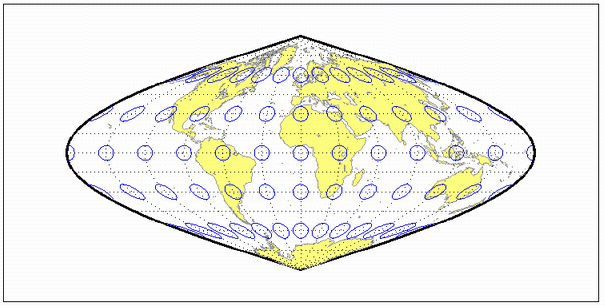sinusoid
Sinusoidal projection
Classification
Pseudocylindrical
Identifier
sinusoid
Graticule
Central Meridian: Straight line half as long as the Equator.
Other Meridians: Equally spaced sinusoidal curves intersecting at the poles and concave toward the central meridian.
Parallels: Equally spaced straight parallel lines, perpendicular to the central meridian.
Poles: Points.
Symmetry: About the central meridian or the Equator.
Features
This projection is equal-area. Scale is true along every parallel and along the central meridian. There is no distortion along the Equator or along the central meridian, but it becomes severe near the outer meridians at high latitudes.
Parallels
This projection has one standard parallel, which is by definition fixed at 0º.
Remarks
This projection was developed in the 16th century. It was used by Jean Cossin in 1570 and by Jodocus Hondius in Mercator atlases of the early 17th century. It is the oldest pseudocylindrical projection currently in use, and is sometimes called the Sanson-Flamsteed or the Mercator Equal-Area projection.
Mapping Toolbox™ uses a different implementation of the sinusoidal projection for displaying coordinates on
axesm-based maps than for projecting coordinates using theprojfwdorprojinvfunction. These implementations may produce differing results.
Example
landareas = shaperead('landareas.shp','UseGeoCoords',true);
axesm ('sinusoid', 'Frame', 'on', 'Grid', 'on');
geoshow(landareas,'FaceColor',[1 1 .5],'EdgeColor',[.6 .6 .6]);
tissot;
Version History
Introduced before R2006a